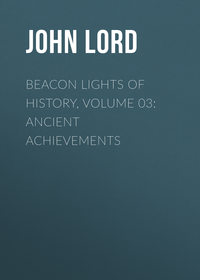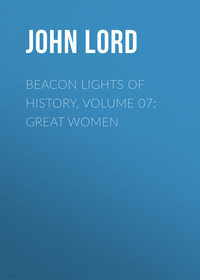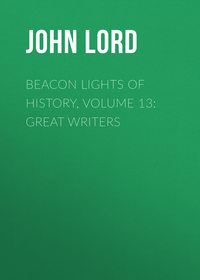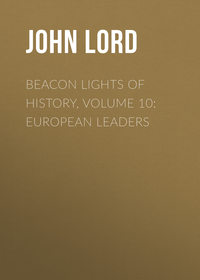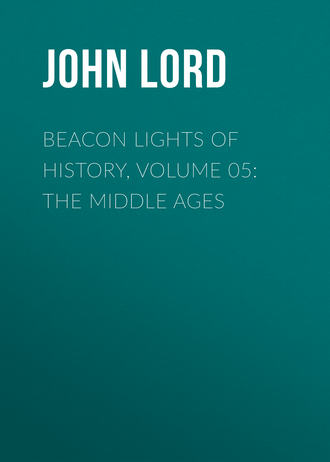 полная версия
полная версияBeacon Lights of History, Volume 05: The Middle Ages
The glorious old architecture whose peculiarity was the pointed arch, flourished only about three hundred years in its purity and matchless beauty. Then another change took place. The ideal became lost in meaningless ornaments. The human figure peoples the naked walls. "Man places his own image everywhere.... The tomb rises like a mausoleum in side chapels. Man is enthroned, not God." The corruption of the art keeps pace with the corruption of the Papacy and the discords of society. In the fourteenth century the Mediaeval has lost its charm and faith.
And then sets in the new era, which begins with Michael Angelo. It is marked by the revival of Greek art and Greek literature. At Florence reign the Medici. On the throne of Saint Peter sits an Alexander VI. or a Julius II. Genoa is a city of merchant-palaces. Museums are collected of the excavated remains of Roman antiquity. Everybody kindles with the contemplation of the long-buried glories of a classic age; everybody reads the classic authors: Cicero is a greater oracle than Saint Augustine. Scholars flock to Italy. The popes encourage the growing taste for Pagan philosophy. Ancient art regains her long-abdicated throne, and wields her sceptre over the worshippers of the Parthenon and the admirers of Aeschylus and Thucydides. With the revived statues of Greece appear the most beautiful pictures ever produced by the hand of man; and with pictures and statues architecture receives a new development. It is the blending of the old Greek and Roman with the Gothic, and is called the Renaissance. Michael Angelo erects St. Peter's, the heathen Pantheon, on the intersection of Gothic nave and choir and transept; a glorious dome, more beautiful than any Gothic spire or tower, rising four hundred and fifty feet into the air. And in the interior are classic circular arches and pillars, so vast that one is impressed as with great feats of engineering skill. All that is variegated in marbles adorns the altars; all that is bewitching in paintings is transferred to mosaics. And this new style of Italy spreads into France and England. Sir Christopher Wren builds St. Paul's,–more Grecian than Gothic,–and fills London with new churches, not one of which is Gothic, and all different. The brain is bewildered in attempting to classify the new and ever-shifting forms of the revived Italian. And so for three hundred years the architects mingle the Gothic with the classical, until now a mongrel architecture is the disgrace of Europe; varied but not expressive, resting on no settled principles, neither on vertical nor on horizontal lines,–blended together, sometimes Grecian porticos on Elizabethan structures, spires resting not on towers but roofs, Byzantine domes on Grecian temples, Greek columns with Lombard arches, flamboyant panelling, pendant pillars from the roof, all styles mixed up together, Corinthian pilasters acting as Gothic buttresses, and pointed arches with Doric friezes,–a heap of diverse forms, alien alike from the principles of Wykeham and Vitruvius.
And this varied mongrel style of architecture corresponds with the confused civilization of the period,–neither Greek nor Gothic, but a mixture of both; intolerant priests wrangling with pagan sceptics and infidels,–Aquaviva with Pascal, the hierarchy of the French Church with Voltaire and Rousseau, Protestant divines with the Catholic clergy; Geneva and Rome compromising at Oxford, the authority of the Fathers made antagonistic to the authority of popes, new vernacular tongues supplanting Latin in the universities; everywhere war on the Middle Ages, without full emancipation from their dogmas, ancient paganism made to uphold the Church, an unbounded activity of intellect casting off all established rules, the revival of the old Greek republics, democracy asserting its claim against absolute power; nothing settled, nothing at rest, but motion in every direction,–science combating faith, faith spurning reason, humanity arrogating divinity, the confusion of races, Babel towers of vanity and pride in the new projected enterprises, Christian nations embroiled in constant wars, gold and silver set up as idols, the rise of new powers in the shapes of new industries and new inventions, commerce filling the world with wealth, armies contending for rights as well as for the aggrandizement of monarchies: was there ever such a simmering and boiling and fermenting period of activities since the world began? In such a wild and tumultuous agitation of passions and interests and ideas, how could Art reappear either in the classic severity of Greek temples or the hoary grandeur of Mediaeval cathedrals? In this jumble we look for new creations, but no creations in art appear, only fantastic imitations. There is no creation except in a new field, that of science and mechanical inventions,–where there is the most extraordinary and astonishing development of human genius ever seen on earth, but "of the earth earthy," aiming at material good. Architecture itself is turned into great feats of engineering. It does not span the apsis of a church; it spans rivers and valleys. The church, indeed, passes out of mind, if not out of sight, in the new material age, in the multiplication of bridges and gigantic reservoirs,–old Rome brought back again in its luxuries.
And yet the exactness of science and the severity of criticism–begun fifty years ago, in the verification of principles–produce a better taste. Architects have sought to revive the purest forms of both Gothic and Grecian. If they could not create a new style, they would imitate the old: as in philosophy, they would go round in the old circles. As science revives the atoms of Democritus, so art would reproduce the ideas of Phidias and Vitruvius, and even the poetry and sanctity of the Middle Ages. Within fifty years Christendom has been covered with Gothic churches, some of which are as beautiful as those built by Freemasons. The cathedrals have been copied rigidly, even for village churches. The Parthenon reappears in the Madeleine. We no longer see, as in the eighteenth century, Gothic spires on Roman basilicas, or Grecian porticos ornamenting Norman towers. The various styles of two thousand years are not mixed up in the same building. We copy either the horizontal lines of Paganism or the vertical lines of the ages of Faith. No more harmonious Gothic edifice was ever erected than the new Catholic cathedral of New York.
The only absurdity is seen when radical Protestantism adopts the church of pomps and liturgies. When the Reformation was completed, men sought to build churches where they could hear the voice of the preacher; for the mission of Protestantism is to teach, not to sing. Protestantism glories in its sermons as much as Catholicism in its chants. If the people wish to return again to ritualism, let them have the Gothic church. If they wish to be electrified by eloquence, let them have a basilica, for the voice of the preacher is lost in high and vaulted roofs. If they wish to join in the prayers and the ceremonies of the altar, let them have the clustering pillars and the purple windows.
Everything turns upon what is meant by a church. What is it for? Is it for liturgical services, or is it for pulpit eloquence? Solve that question, and you solve the Reformation. "My house," saith the Divine Voice, "shall be called the house of prayer." It is "by the foolishness of preaching," said Paul, that men are saved.
If you will have the prayers of the Middle Ages and the sermons of the Reformation both together, then let the architects invent a new style, which shall allow the blending of prayer and pulpit eloquence. You cannot have them both in a Grecian temple, or in a Gothic church. You must combine the Parthenon with Salisbury, which is virtually a new miracle of architecture. Will that miracle be wrought? I do not know. But a modern Protestant church, with all the wonders of our modern civilization, must be something new,–some new combination which shall be worthy of the necessity of our times. This is what the architect must now aspire to accomplish; he must produce a house in which one can both hear the sermon, and be stimulated by inspiring melodies,–for the Church must have both. The psalms of David and the chants of Gregory must be blended with the fervid words of a Chrysostom and a Chalmers.
This, at least, should be borne in mind: the church edifice must be adapted to the end designed. The Gothic architects adapted their vaults and pillars to the ceremonies of the Catholic ritual. If it is this you want, then copy Gothic cathedrals. But if it is preaching you want, then restore the Grecian temple,–or, better still, the Roman theatre,–where the voice of the preacher is not lost either in Byzantine domes or Gothic vaults, whose height is greater than their width. The preacher must draw by the distinctness of his tones; for every preacher has not the musical voice of Chrysostom, or the electricity of St. Bernard. He can neither draw nor inspire if he cannot be heard; he speaks to stones, not to living men or women. He loses his power, and is driven to chants and music to keep his audience from deserting him. He must make his choir an orchestra; he must hide himself in priestly vestments; he must import opera singers to amuse and not instruct. He cannot instruct when he cannot be heard, and heard easily. Unless the people catch every tone of his voice his electricity will be wasted, and he will preach in vain, and be tired out by attempting to prevent echoes. The voice of Saint Paul would be lost in some of our modern fashionable churches. Think of the absurdity of Baptists and Methodists and Presbyterians affecting to restore Gothic monuments, when the great end of sacred eloquence is lost in those devices which appeal to sense. Think of the folly of erecting a church for eight hundred people as high as Westminster Abbey. It is not the size of a church which prevents the speaker from being heard,–it is the disproportion of height with breadth and length, and the echoes produced by arcades. Spurgeon is heard easily by seven thousand people, and Talmage by six thousand, and Dr. Hall by four thousand, because the buildings in which they preach are adapted to public speaking. Those who erect theatres take care that a great crowd shall be able to catch even the whispers of actors. What would you think of the good sense and judgment of an architect who should construct a reservoir that would leak, in order to make it ornamental; or a schoolhouse without ventilation; or a theatre where actors could only be seen; or a hotel without light and convenient rooms; or a railroad bridge which would not support a heavy weight?
A Protestant church is designed, no matter what the sect may be to which it belongs, not for poetical or aesthetic purposes, not for the admiration of architectural expenditures, not even for music, but for earnest people to hear from the preacher the words of life and death, that they may be aroused by his enthusiasm, or instructed by his wisdom; where the poor are not driven to a few back seats in the gallery; where the meeting is cheerful and refreshing, where all are stimulated to duties. It must not be dark, damp, and gloomy, where it is necessary to light the gas on a foggy day, and where one must be within ten feet of the preacher to see the play of his features. Take away facilities for hearing and even for seeing the preacher, and the vitality of a Protestant service is destroyed, and the end for which the people assemble is utterly defeated. Moreover, you destroy the sacred purposes of a church if you make it so expensive that the poor cannot get sittings. Nothing is so dull, depressing, funereal, as a church occupied only by prosperous pew-holders, who come together to show their faces and prove their respectability, rather than to join in the paeans of redemption, or to learn humiliating lessons of worldly power before the altar of Omnipotence. To the poor the gospel is preached; and it is ever the common people who hear most gladly gospel truth. Ah, who are the common people? I fancy we are all common people when we are sick, or in bereavement, or in adversity, or when we come to die. But if advancing society, based on material wealth and epicurean pleasure, demands churches for the rich and churches for the poor,–if the lines of society must be drawn somewhere,–let those architects be employed who understand, at least, the first principles of their art. I do not mean those who learn to draw pictures in the back room of a studio, but conscientious men, if you cannot find sensible men. And let the pulpit itself be situated where the people can hear the speaker easily, without straining their eyes and ears. Then only will the speaker's voice ring and kindle and inspire those who come together to hear God Almighty's message; then only will he be truly eloquent and successful, since then only does his own electricity permeate the whole mass; then only can he be effective, and escape the humiliation of being only a part of a vain show, where his words are disregarded and his strength is wasted in the echoes of vaults and recesses copied from the gloomy though beautiful monuments of ages which can never, never again return, any more than can "the granite image worship of the Egyptians, the oracles of Dodona, or the bulls of the Mediaeval popes."
AUTHORITIES
Fergusson's History of Architecture; Durand's Parallels; Eastlake's Gothic and Revival; Ruskin, Daly, and Penrose; Britton's Cathedrals and Architectural Antiquities; Pugin's Specimens and Examples of Gothic Architecture; Rickman's Styles of Gothic Architecture; Street's Gothic Architecture in Spain; Encyclopaedia Britannica (article Architecture).
JOHN WYCLIF
The name of Wyclif suggests the dawn of the Protestant Reformation; and the Reformation suggests the existence of evils which made it a necessity. I do not look upon the Reformation, in its earlier stages, as a theological movement. In fact, the Catholic and Protestant theology, as expounded and systematized by great authorities, does not materially differ from that of the Fathers of the Church. The doctrines of Augustine were accepted equally by Thomas Aquinas and John Calvin. What is called systematic divinity, as taught in our theological seminaries, is a series of deductions from the writings of Paul and other apostles, elaborately and logically drawn by Athanasius, Jerome, Augustine, and other lights of the early Church, which were defended in the Middle Ages with amazing skill and dialectical acuteness by the Scholastic doctors, with the aid of the method which Aristotle, the greatest logician of antiquity, bequeathed to philosophy. Neither Luther nor Calvin departed essentially from these great deductions on such vital subjects as the existence and attributes of God, the Trinity, sin and its penalty, redemption, grace, and predestination. The creeds of modern Protestant churches are in harmony with the writings of both the Fathers and the Scholastic doctors on the fundamental principles of Christianity. There are, indeed, some ideas in reference to worship, and the sacraments, and the government of the Church, and aids to a religious life, defended by the Scholastic doctors, which Protestants do not accept, and for which there is not much authority in the writings of the Fathers. But the main difference between Protestants and Catholics is in reference to the institutions of the Church,–institutions which gradually arose with the triumph of Christianity in its contest with Paganism, and which received their full development in the Middle Ages. It was the enormous and scandalous corruptions which crept into these institutions which led to the cry for reform. It was the voice of Wyclif, denouncing these abuses, which made him famous and placed him in the van of reformers. These abuses were generally admitted and occasionally attacked by churchmen and laymen alike,–even by the poets. They were too flagrant to be denied.
Now what were the prominent evils in the institutions of the Church which called for reform, and in reference to which Wyclif raised up his voice?–for in his day there was only one Church. An enumeration of these is necessary before we can appreciate the labors and teachings of the Reformer. I can only state them; I cannot enlarge upon them. I state only what is indisputable, not in reference to theological dogmas so much as to morals and ecclesiastical abuses.
The centre and life and support of all was the Papacy,–an institution, a great government, not a religion.
I have spoken of this great power as built up by Leo I., Gregory VII., and Innocent III., and by others whom I have not mentioned. So much may be said of the necessity of a central spiritual power in the dark ages of European society that I shall not combat this power, or stigmatize it with offensive epithets. The necessities of the times probably called it into existence, like other governments, although I cannot see any argument drawn from the Scriptures, or from the history of the early Apostolic Church, to warrant its existence. Nor would I defend the long series of papal usurpations by which the Roman pontiffs got possession of the government of both Church and State. I speak not of their quarrels with princes about investitures, in which their genius and their heroism were displayed rather than by efforts in behalf of civilization.
But the popes exercised certain powers and prerogatives in England, about the time of Wyclif, which were exceedingly offensive to the secular rulers of the land. They claimed the island as a sort of property which reason and the laws did not justify,–a claim which led to heavy exactions and forced contributions on the English people that crippled the government and impoverished the nation. Boys and favorites were appointed by the popes to important posts and livings. Church preferments were almost exclusively in the hands of the Pope; and these were often bought. A yearly tribute had been forced on the nation in the time of John. Peter's pence were collected from the people. Enormous sums, under various pretences, flowed to Rome. And the clergy were taxed as well as the laity. The contributions which were derived from the sale of benefices, from investitures, from the transfer of sees, from the bestowal of rings and crosiers (badges of episcopal authority), from the confirmation of elections, and other taxes, irritated sovereigns, and called out the severest denunciation of statesmen.
Closely connected with papal exactions was the enormous increase of the Mendicant friars, especially the Dominicans and Franciscans, who had been instituted by Innocent III. to uphold the papal domination. These itinerating beggars in their black-and-gray gowns infested every town and village in England. For a century after their institution, they were the ablest and perhaps the best soldiers of the Pope, and did what the Jesuits afterwards performed, and perhaps the Methodists a hundred years ago,–gained the hearts of the people and stimulated religious life; but in the fourteenth century they were a nuisance. They sold indulgences, they invented pious frauds, they were covetous under pretence of poverty, they had become luxurious in their lives, they slandered the regular clergy, they usurped the prerogatives of parish priests, they enriched their convents, they accommodated themselves to the wishes of the great, and were marked by those peculiarities of which the Jesuits were accused in the time of Pascal. As they had not in England, as in Spain and Italy, tribunals of inquisition, they were ridiculed, despised, and hated, rather than feared. One gets the truest impression of the popular estimate of these friars from the sarcasms of Chaucer. The Friar Tuck whom Sir Walter Scott has painted was a very different man from the Dominicans or the Franciscans of the thirteenth century, when they reigned in the universities, and were the confessors of monarchs and the most popular preachers of their time. In the fourteenth century they were consumed with jealousies and rivalries and animosities against each other; and all the various orders,–Dominican, Franciscan, Carmelite,–in spite of their professions of poverty, were the possessors of magnificent monasteries, and fattened on the credulity of the world. Besides these Mendicant friars, England was dotted with convents and religious houses belonging to the different orders of Benedictines, which, though enormously rich, devoured the substance of the poor. There were more than twenty thousand monks in a population of three or four millions; and most of them led idle and dissolute lives, and were subjects of perpetual reproach. Reforms of the various religious houses had been attempted, but all reforms had failed. Nor were the lives of the secular clergy much more respectable than those of the great body of monks. They are accused by all historians of avarice, venality, dissoluteness, and ignorance; and it was their incapacity, their disregard of duties, and indifference to the spiritual interests of their flocks that led to the immense popularity of the Mendicant friars, until they, in their turn, became perhaps a greater scandal than the parish priests whose functions they had usurped. Both priests and monks in the time of Bishop Grostête of Lincoln frequented taverns and gambling-houses. So enormous and scandalous was the wealth of the clergy, that as early as 1279, under Edward I., Parliament passed a statute of mortmain, forbidding religious bodies to receive bequests without the King's license.
With the increase of scandalous vices among the clergy was a corruption in the doctrines of the Church; not those which are strictly theological, but those which pertained to the sacraments, and the conditions on which absolution was given and communion administered. In the thirteenth century, as the Scholastic philosophy was reaching its fullest development, we notice the establishment of the doctrine of transubstantiation, the withholding the cup from the laity, and the necessity of confession as the condition of receiving the communion,–which corruptions increased amazingly the power of the clergy over the minds of superstitious people, and led to still more flagrant evils, like the sale of indulgences and the perversion of the doctrine of penance, originally enforced in order to aid the soul to overcome the tyranny of the body, but finally accepted as the expiation for sin; so that the door of heaven itself was opened by venal priests only to those whom they could control or rob.
Such was the state of the Church when Wyclif was born,–in 1324, near Richmond in Yorkshire, about a century after the establishment of universities, the creation of the Mendicant orders, and the memorable usurpation of Innocent III.
In the year 1340, during the reign of Edward III., we find him at the age of sixteen a student in Merton College at Oxford,–the college then most distinguished for Scholastic doctors; the college of Islip, of Bradwardine, of Occam, and perhaps of Duns Scotus. It would seem that Wyclif devoted himself with great assiduity to the study which gave the greatest intellectual position and influence in the Middle Ages, and which required a training of nineteen years in dialectics before the high degree of Doctor of Divinity was conferred by the University. We know nothing of his studious life at Oxford until he received his degree, with the title of Evangelical or Gospel Doctor,–from which we infer that he was a student of the Bible, and was more remarkable for his knowledge of the Scriptures than for his dialectical skill. But even for his knowledge of the Scholastic philosophy he was the most eminent man in the University, and he was as familiar with the writings of Saint Augustine and Jerome as with those of Aristotle. It was not then the fashion to study the text of the Scriptures so much as the commentaries upon it; and he who was skilled in the "Book of Sentences" and the "Summa Theologica" stood a better chance of preferment than he who had mastered Saint Paul.
But Wyclif, it would seem, was distinguished for his attainments in everything which commanded the admiration of his age. In 1356, when he was thirty-two, he wrote a tract on the last ages of the Church, in view of the wretchedness produced by the great plague eight years before. In 1360, at the age of thirty-six, he attacked the Mendicant orders, and his career as a reformer began,–an unsuccessful reformer, indeed, like John Huss, since the evils which he combated were not removed. He merely protested against the corruptions which good men lamented; and that is nearly all that great men can do when they are beyond their age. They are simply witnesses of truth, and fortunate are they if they do not die as martyrs; for in the early Church "witnesses" and "martyrs" were synonymous ([Greek: martyres]). The year following, 1361, Wyclif was presented to the rich rectory of Fillingham by Baliol College, and was promoted the same year to the wardenship of that ancient college. The learned doctor is now one of the "dons" of the university,–at that time, even more than now, a great dignitary. It would be difficult for an unlearned politician of the nineteenth century to conceive of the exalted position which a dignitary of the Church, crowned with scholastic honors, held five hundred years ago. It gave him access to the table of his sovereign, and to the halls of Parliament. It made him an oracle in all matters of the law. It created for him a hearing on all the great political as well as ecclesiastical issues of the day. What great authorities in the thirteenth century were Albertus Magnus, Thomas Aquinas, and Bonaventura! Scarcely less than they, in the next century, were Duns Scotus and John Wyclif,–far greater in influence than any of the proud feudal lords who rendered service to Edward III., broad as were their acres, and grand as were their castles. Strange as it may seem, the glory that radiated from the brow of a scholar or a saint was greatest in ages of superstition and darkness; perhaps because both scholars and saints were rare. The modern lights of learning may be better paid than in former days, but they do not stand out to the eye of admiring communities in such prominence as they did among our ancestors. Who stops and turns back to gaze reverentially on a poet or a scholar whom he passes by unconsciously, as both men and women strained their eyes to see an Abélard or a Dante? Even a Webster now would not command the homage he received fifty years ago.




